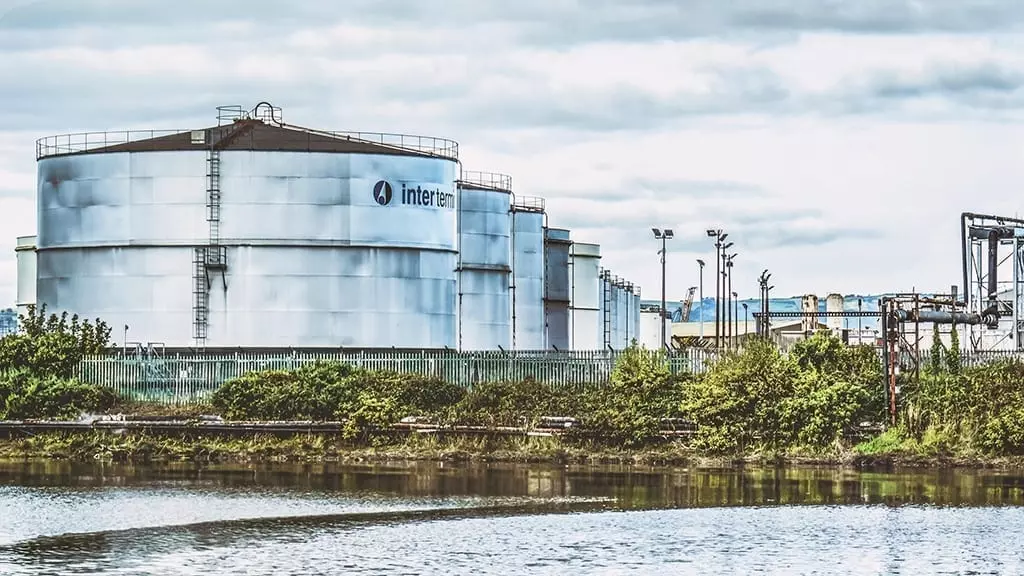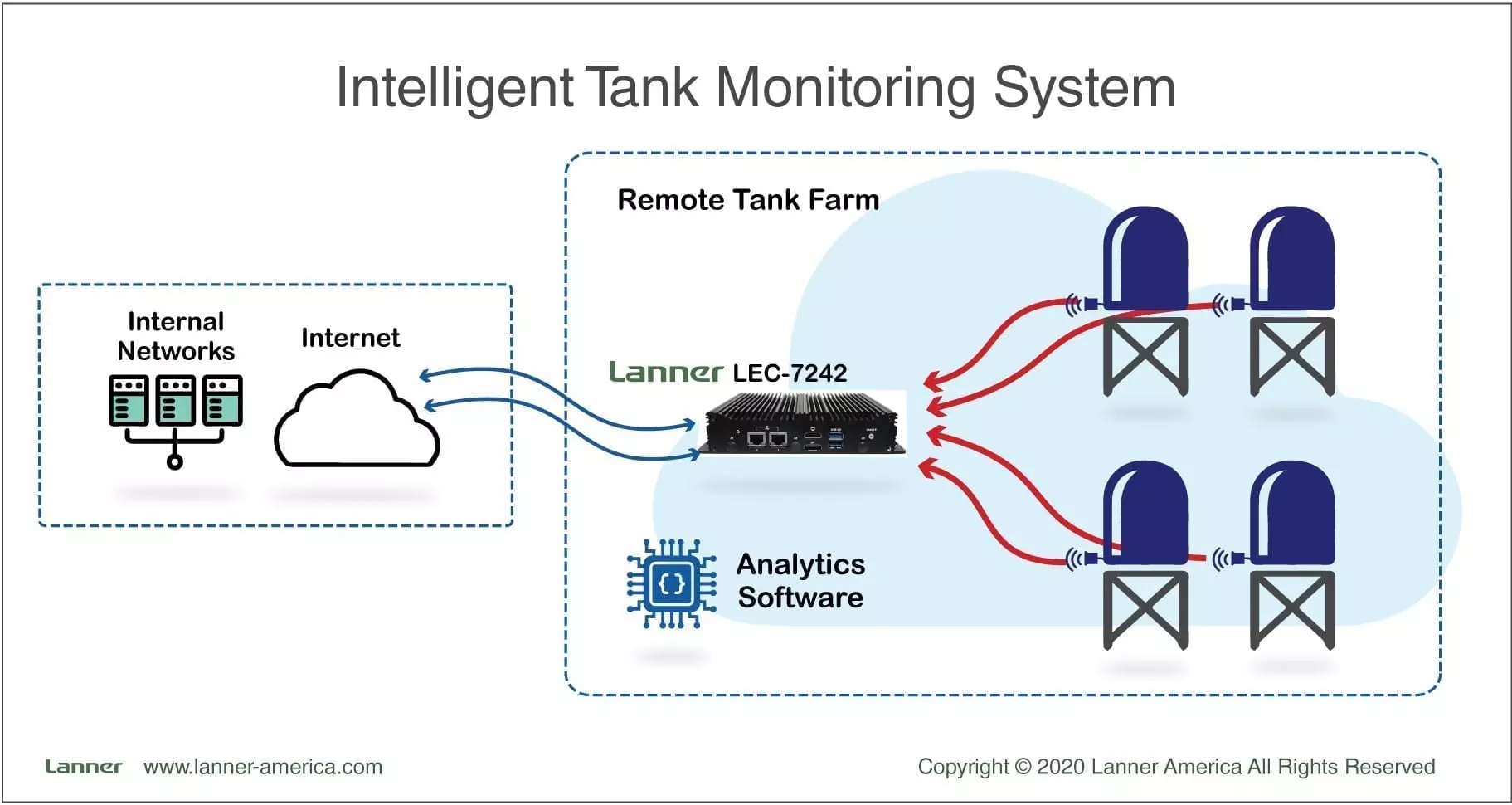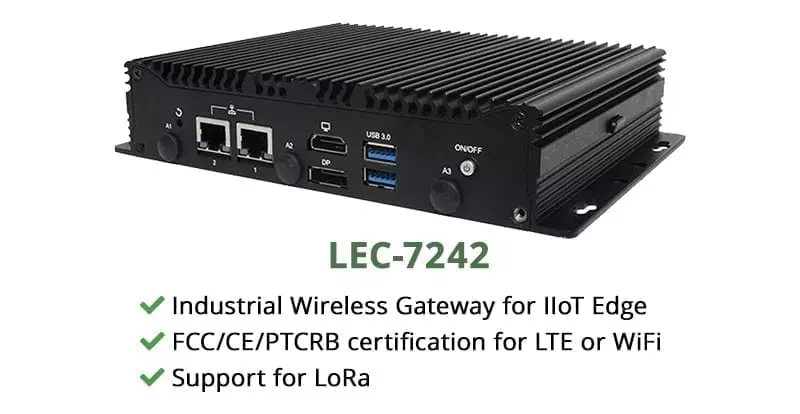
The purpose of intelligent tank monitoring systems is to keep track of the tank’s content level with metrics like temperature and pressure. These systems use a combination of state-of-the-art communication’s technology and intelligent edge analytics.
A remote tank monitoring solution lets you keep track of the tank liquid’s level and temperature from anywhere in the world. Monitor single tanks, multiple distributed tanks, farms tanks, and anything storing from fuels to lubricants, water, chemicals, and fertilizers.
Summary
Remote tanks storing liquids have been traditionally monitored using costly wired SCADA infrastructure—a nearby server wired to a remote terminal unit centralizing data gathered by sensors.
SCADA is a fantastic supervisory and control system for inside-the-fence applications with easy access to power and network, but outside-the-fence remote applications are a different story. Telemetry and remote SCADA promised to solve the lack of network access but left it with more challenges.
We will be reviewing an Intelligent Tank Monitoring Solution to address most of these challenges. The solution is based on LEC-7242’s Industrial IoT Wireless Gateway, which connects various sensors deployed across remote tanks in different locations. The IoT gateway supports LoRa for sensor long-range and low-power downstream and WiFi and LTE for upstream communications.
Challenges
SCADA is fantastic for monitoring inside-the-fence industrial applications. But out-the-fence applications like tank monitoring have entirely different requirements.
Once you put SCADA to monitor remote tanks, the power consumption and communications become the most significant challenges. In SCADA, the Remote Telemetry Units (RTUs) receive data from sensors, PLCs, detectors, pumps, etc., and transmit it using their radios. This is all good in an inside-fence application, where power or telecom are wired to a central source. But when autonomous RTUs use their radios to transmit/receive information to an antenna far away, they’ll likely consume a large portion of their energy resources.
Power and network limitations
Access to power and networks is one of the main challenges when employing a SCADA for tank monitoring. Remote sensing units need reliable energy to use their radios to send data periodically. Network coverage and efficiency are the other main challenges, as there is usually no coverage in these remote areas.
Telemetry “remote SCADA” solutions entail higher costs
Addressing the communications limitations of SCADA with long-range satellite communications may result in expensive maintenance costs. Additionally, the energy needed for autonomy will require larger batteries, solar panels, satellite receivers, more maintenance, and replacements. All repairs of network infrastructure need to be performed at the site – this entails spending more resources for operations. The solution becomes an additional burden, as the telecom/power infrastructure will be regularly inspected and maintained.
Traditional IT was not made for challenging environments
Tanks are not deployed in your typical “everyday” datacenter. These out-the-fence applications pose a big challenge for traditional IT appliances. These IT appliances are designed to work at “server room” conditions. So when they are deployed outside, they will not stand against environmental conditions like extreme temperature fluctuations and humidity.
The Intelligent Tank Monitoring System
The intelligent tank monitoring solution is based on the following components: The IoT sensors, the rugged IoT gateway, and the analytics software.

IoT Sensors
IoT sensors should measure pressure levels to determine the tank’s liquid level, but additional metrics like temperature changes may also help detect abnormalities.
The IoT sensor nodes collect data and transfer it to a nearby IoT gateway. The gateway connects (at a tank level) all the sensors via a wireless interface such as LoRa or WiFi. The gateway runs analytics on the collected data to reduce network latency and bandwidth demand. Then it sends all collected data remotely using cellular networks (4G-LTE).
The IoT Gateway
An industrial IoT gateway is the network node that serves as the access point for the tank’s sensors to another network (usually an IT network). It performs the routing between the IoT sensors and the remote monitoring center (or Internet).
Lanner’s LEC-7242 is an industrial wireless gateway with Intel® Apollo Lake CPU and FCC/CE/PTCRB certification for LTE or WiFi. The gateway is designed explicitly to work with the IIoT and IoT network edge. It combines its intelligent edge capabilities with state-of-the-art communication.
LEC-7242 performs data analysis with additional software. The device also comes with wireless support for downstream interfaces LoRa, WiFi, and upstream interface for LTE-4G to forward the results to a remote network.

LEC-7242 Additional Key Features
- Support for LoRa. LEC-7242 also integrates with LoRa (Long Range) technology to provide long-range and low power wireless communication for IoT devices. The LoRa’s radio interface is handy for tank monitoring because it allows for the best passive low data rate connectivity for sensors deployed in remote areas.
- Wireless support. With wireless technologies like LoRa or WiFi, the sensors deployed across the tank can create a Wireless Sensor Network (WSN) with the LEC-7242 gateway. The device comes with FCC/CE/PTCRB certification for LTE or WiFi.
- Rugged design. The LEC-7242 appliance is an excellent fit for external operations. It comes in a fanless case, and it is built with stainless steel aluminum (SGCC). It can work under broad weather conditions (0°C~50°C / -20°C~70°C) and relative humidity of 5%~95%.
- Graphics Processing. LEC-7242 features Intel® HD Graphics 500 and supports a display via one HDMI port and one DisplayPort.
The Analytics Software.
With additional software, the wireless industrial gateway may perform specific tank monitoring data analysis on-site. The software feeds with all raw data from sensors and then performs data analysis at the sensor level. The output can be used to create remote data visualizations of the tank’s liquid levels, automate monitoring, find leaks and other faults, or even for capacity planning.
The Benefits of Intelligent Tank Monitoring System
The solution may benefit many scenarios, from fuel tank monitoring to water tank monitoring systems and even oil and gas tank monitoring. But regardless of content, the purpose of the solution is tank level monitoring. The solution can also perform temperature monitoring and provide additional analytics for added services.
So, what are the benefits?
Streamline access to the tank’s content
Tank operators can make the monitoring process more efficient. They can inspect the fluid’s fill levels and other sensitive information like temperature without traveling to the tank’s location. With only an Internet connection, they can remotely keep track of the exact levels in the tank. Not having to inspect inside tanks also helps chemical and fertilizer industries reduce accidents by monitoring hazardous content remotely.
With more convenient access to the tank’s data, operators will refill or empty the tank’s content only when needed. This also leads to better inventory management for multiple tanks across different locations.
Reduce overall cost (OPEX and CAPEX)
Overall, the intelligent tank monitoring solution requires low initial capital expenses than other solutions. Additionally, spend less time and money with the tank’s inspection monitoring operations. Human resources can be repurposed for different tasks, plus they are out of risk for specific complex and hazardous manual inspections.
Improve communication for remote assets.
If all smart sensors deployed across the tank generate and send large amounts of data continuously to the cloud, the amount of bandwidth needed on-site can be overwhelming. With LEC-7242, the data is pre-processed on-site, reducing the amount of data that needs to be sent remotely. With fewer data to handle, the solution can dramatically reduce the bandwidth, latency, and processing. The critical data like early-stage leaks or changes in pressure will be sent reactively, while the non-critical data can be sent passively.
Helps solve the SCADA limitations
Existing limitations in long-range and power consumption data transmission have created challenges for SCADA technology for remote assets. But now, the improvements in sensing devices’ radios with lower power consumption and better signal range, such as LoRA technology, make SCADA an integral part of the solution.
Automate tank level monitoring, alerting, and predicting
The added edge analytics can provide other modern services; for example, automated monitoring can detect violated thresholds, send alerts, or create reports. Additionally, if a certain level is reached, the intelligent system can activate triggers, such as closing or opening valves. Other services like predictive maintenance can also track different components like valves, pipes, and the tank’s overall state. Tank’s capacity planning can also help to foresee the company’s stock.
Next Steps
For more information on other Industrial IoT Gateways or the Intelligent Tank Monitoring System please contact Lanner’s sales representative.
Photo by K. Mitch Hodge on Unsplash






